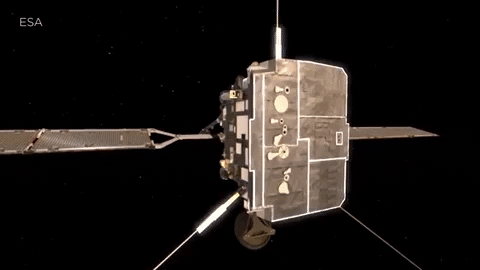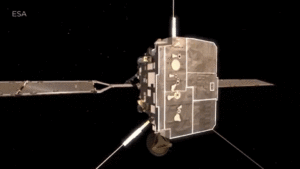NASA-ESA Solar Orbiter is set to launch into space on Sunday, February, 9, 2020 at 11:03 p.m Eastern. And it packs ten powerful scientific instruments on board that will shed unprecedented light on our Sun. The mission is an ambitious collaboration between the European Space Agency and NASA. It aims to resolve some of the biggest mysteries surrounding the Sun.
Scientists have observed the Sun since the dawn of astronomy, but still don’t have the answers to questions like how the Sun’s magnetic field operates, how it affects the star’s polar regions or what drives the solar wind. One key question scientists hope to answer with the mission is what drives solar cycles “moments that occur every 11 years when the Sun’s magnetic poles switch”.
We know that the Sun exhibits this 11-year activity cycle. We don’t really know what drives this cycle of 11 years and we can’t predict how strong the next cycle is going to be. To get those answers, the Solar Orbiter will travel closer to the Sun than any other spacecraft before it, essentially flying outside the confines of the Solar System in order to peer down at the Sun, studying the star from a high altitude.
The spacecraft carries 10 scientific instruments. Six of the instruments are remote sensing, capturing images of the Sun, while the remaining four are in-situ instruments. which will measure solar wind, plasma and other aspects of the environment around the spacecraft.
The unique feature of this mission is that these instruments are able to work together, because they are able to talk to each other. If one of the instruments detects an interesting observation, then it will notify other relevant instruments so that they can do their own measurements, too. There work as a team is totally awesome.
THE INSTRUMENTS ARE:
- EUI: Extreme Ultraviolet Imager
- Metis
- PHI: Polarimetric and Helioseismic Imager
- SoloHi: Solar Orbiter Heliospheric Imager
- SPICE: Spectral Imaging of the Coronal Environment
- STIX: X-ray Spectrometer/Telescope
- EPD: Energy Particle Detector
- MAG: Magnetometer
- RPW: Radio and Plasma Waves
- SWA: Solar Wind Plasma Analyzer
EUI: EXTREME ULTRAVIOLET IMAGER
This instrument will capture ultra-violet images of the lower layers of the solar atmosphere, which lie just above the surface of the Sun. The imager will help scientists understand how the Sun’s lower atmosphere heats up, and how that influences the larger corona or the outermost part of the solar atmosphere. The imager is located in an optics box behind the spacecraft’s heat shield.
METIS
Metis will capture images of the Sun’s outer atmosphere. The instrument will image the corona, which is dimmer than the rest of the atmospheric layers, in both visible and extreme ultraviolet light. It manages this feat by blocking light from Sun’s bright surface. Metis will capture the corona at a distance of approximately 302,000 and 908,000 miles from the Sun’s surface, closer than any other coronagraph has gotten to the Sun. By observing this area of the Sun’s atmosphere, scientists can gain a better understanding of how the Sun affects the rest of the heliosphere.
PHI: POLARIMETRIC AND HELIOSEISMIC IMAGER
PHI is made up of two telescopes — a full-disk telescope, which views the whole Sun at any given time, and a high-resolution telescope, which views just a portion of the Sun, revealing its fine structure in detail. The two telescopes produce magnetograms, which are maps of the magnetic peaks and valleys on the Sun’s surface. Together they enable scientists to estimate the magnetic field in the solar corona and heliosphere. The Sun’s magnetic field is key to understanding its behaviour. It is believed to be the main driving force behind the 11-year solar cycle whereby the Sun’s North and South poles flip.
SOLOHI: SOLAR ORBITER HELIOSPHERIC IMAGER
SoloHi is a visible-light telescope that will image sunlight as it is reflected off electrons in the solar wind. The telescope will focus on the interplanetary medium or the space that lies between the Sun and the planets. This area is crucial to predicting when and understanding how eruptions from the Sun will take place and whether or not they will affect Earth. At its closest approach, the telescope will capture a region from about 2.25 million miles to approximately 18 million miles from the Sun.
SPICE: SPECTRAL IMAGING OF THE CORONAL ENVIRONMENT
SPICE is an extreme ultraviolet spectrometer designed to map the plasma or streams of hot gas, that erupt from the Sun’s surface in the form of the solar wind. The instrument will collect data on the density and flow of the solar material.
STIX: X-RAY SPECTROMETER/TELESCOPE
This instrument is designed to survey X-rays as they erupt from the surface of the Sun during solar flares. STIX will take note of the timing, location and intensity of each X-ray burst from the Sun. Doing so will help scientists figure out how these solar flares erupt. The instrument has a wide-field view, meaning it can see the entire Sun at any given time. Solar flares pose a threat to space equipment such as satellites and they are a hazard for astronauts journeying through deep space.
EPD: ENERGETIC PARTICLE DETECTOR
EPD measures electrons and other particles emitted by the Sun, as well as their timing and distribution. It will help scientists understand how solar radiation forms by breaking down components of the solar wind plasma and the Sun’s magnetic field.
MAG: Magnetometer
This instrument will measure the strength and direction of the magnetic field around the Solar Orbiter. The Magnetometer will help scientists trace the origins of the magnetic field and solar wind plasma in the corona. It will also reveal how energetic-particle radiation travels out into the Solar System following solar eruptions.
SWA: Solar Wind Analyzer Suite
As the Sun blows solar wind towards the spacecraft, this instrument will measure more than 99% of all the charged particles emitted by the star. The measurements can help scientists in determining exactly what the solar wind is made up of and where the streams of solar wind come from.
RPW: Radio and Plasma Waves
This instrument is designed to measure changes in the electric and magnetic fields around the spacecraft. The data will help identify the role plasma plays in the solar wind, whether it helps in its acceleration or heating.
The data which will be collected from the craft’s 10 scientific instruments will help scientists resolve some mysteries regarding our host star, namely what drives solar wind and how it affects the Solar System, including our own planet Earth.

